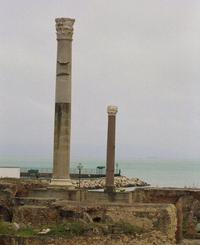
Photo. Remains of Carthage, Tunis, Tunisia - an ancient superpower.
Carthage from the Phoenician Qart-ḥadašt meaning New City, implying it was a 'new Tyre' refers to a series of cities on the Gulf of Tunis, from a Phoenician colony of the 1st millennium BC to the current suburb outside Tunis, Tunisia.
The first civilization that developed within the city's sphere of influence is referred to as Punic (a form of the word "Phoenician") or Carthaginian.
Watch more photos on Travel Explorations` Facebook page.
The city of Carthage is located on the eastern side of Lake Tunis across from the centre of Tunis. According to Roman legend it was founded in 814 BC by Phoenician colonists from Tyre under the leadership of Elissa (Queen Dido).
It became a large and rich city and thus a major power in the Mediterranean. The resulting rivalry with Syracuse and Rome was accompanied by several wars with respective invasions of each other's homeland.
The remains of the once powerful city in northern Africa did a huge impression on me - an extensive archaeological site, located on a hill dominating the Gulf of Tunis and the surrounding plain.
I admired the outline of the great harbor, the ruins of the homes and palaces from the time when the city of Carthage ruled the Mediterranean. It witnessed of a dramatic history. Carthage grew to become the most powerful city in the Mediterranean before the rise of Rome. Carthage was founded by Phoenicians in 113 B.C., and become destroyed in 146 B.C. After that its lands become the Roman province Africa.
Hannibal's invasion of Italy in the Second Punic War culminated in the Carthaginian victory at Cannae and led to a serious threat to the continuation of Roman rule over Italy; however, Carthage emerged from the conflict at its historical weakest.
After the Third Punic War, the city was destroyed by the Romans in 146 BC. However, the Romans refounded Carthage, which became one of the three most important cities of the Empire and the capital of the short-lived Vandal kingdom. It remained one of the most important Roman cities until the Muslim conquest when it was destroyed a second time in AD 698.
Stein Morten Lund, 20 January 2010, updated 30th May 2015












